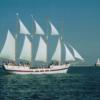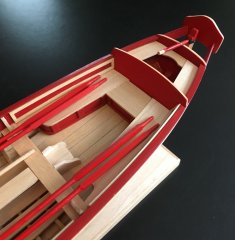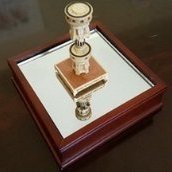
TomShipModel
-
Posts
289 -
Joined
-
Last visited
Reputation Activity
-
 TomShipModel got a reaction from mtaylor in HM Cutter Cheerful 1806 by Stuntflyer (Mike) - FINISHED - 1:48 scale
TomShipModel got a reaction from mtaylor in HM Cutter Cheerful 1806 by Stuntflyer (Mike) - FINISHED - 1:48 scale
Very well done Mike. Your workmanship is tidy and the finish looks good.
-
 TomShipModel got a reaction from Jack12477 in HM Cutter Cheerful 1806 by Stuntflyer (Mike) - FINISHED - 1:48 scale
TomShipModel got a reaction from Jack12477 in HM Cutter Cheerful 1806 by Stuntflyer (Mike) - FINISHED - 1:48 scale
Very well done Mike. Your workmanship is tidy and the finish looks good.
-
 TomShipModel reacted to Stuntflyer in HM Cutter Cheerful 1806 by Stuntflyer (Mike) - FINISHED - 1:48 scale
TomShipModel reacted to Stuntflyer in HM Cutter Cheerful 1806 by Stuntflyer (Mike) - FINISHED - 1:48 scale
While working on the topsail yard, I noticed that I needed a few more belaying pins. These were made from 1/16" square boxwood strips and the Dremel rotary tool. Using a 1/16" collet, the bottom end of the pin was reduced to .032" (1 1/2" scale). After cutting the handle of the pin to the correct length, the bottom end was inserted into a 1/32" collet and the pin was reduced to .045 (2 5/32" scale) From here the handle was easily shaped, and the bottom was trimmed off. Final length = 18" scale.
The topsail yard is completed and all lines are belayed. I still need to trim the lines and add the remaining rope coils.
-
 TomShipModel reacted to Stuntflyer in HM Cutter Cheerful 1806 by Stuntflyer (Mike) - FINISHED - 1:48 scale
TomShipModel reacted to Stuntflyer in HM Cutter Cheerful 1806 by Stuntflyer (Mike) - FINISHED - 1:48 scale
I've been tidying up a bit lately. Managed to get some paint on the chainplates, which are now ready for weathering. I just need to decide what look to go for. Most of the rigging needed some tightening up as well. The two eyebolts that secure the bobstay to the hull where moved forward to prevent the bobstay from interfering with the anchor hoisting. The eyebolts are now 1 1/4" from the stem. The original holes where filled and re-painted. The two ladders that were apparently not glued down securely and knocked off during the rigging process are now on the deck.
The thrill of the day, at least for me, was getting the starboard side ratlines completed. The shrouds where checked after every square knot and clove hitch was tightened to insure that there was no hourglass shape creeping in. I found this to be an very interesting process. I learned a lot and planning ahead definitely helps things go easier.
Hopefully this is what ratlines are supposed to look like. . .
Mike
-
 TomShipModel reacted to JerseyCity Frankie in Sandpaper. Use. It.
TomShipModel reacted to JerseyCity Frankie in Sandpaper. Use. It.
I debated writing this but then thought it couldn't hurt: sandpaper. Use it! I don't want to name and shame anyone, but there is a huge proportion of finished models displayed on MSW on which the detailed photos of deck fittings or mast details show a lack of adequate sanding and surface prep. It looks like a lot of builders punch out the laser cut parts and incorporate them directly into the model without sanding to an adequate degree. I KNOW that close up photography of small parts reveals flaws not visible to the naked eye but some of the model photos I see show that a lot of small wooden parts are going onto models without enough sanding taking place, the surfaces are often covered in irregular globs bumps and spikes.
since most kit models are basswood, it helps to recognize that the biggest drawback of basswood is it's fuzzyness. In other respects it's a great material but at the near-microscopic level fibers at the edges are very stringy, they don't break off neatly at the surface of the wood but cling on randomly as fuzz. Paint or varnish going on over this fuzz only serves to make the fuzz bolder and stick out in hardened spikes and that's what I'm looking at in these detail photos I'm seeing. I'm going to make another plug for the use of a Sanding Sealer. Available in any hardwear store, one can should last your entire modeling career. I use a water based Minwax Sanding Sealer. It paints on like thin acrylic paint, completely transparent. When dry it has the effect of darkening the wood just a bit. Is that so bad? The surface you get has hardened and feels shellacked. When you go over it with fine sandpaper those annoying stringy grainy fibers break right off at the surface in a way that reminds you of those old animated cross sectional shaving razor commercials in which each hair is lifted and cut perfectly at its base. You get a smooth surface where the grain is still visible but not in the form of huge peaks and deep valleys, a surface that can withstand the scrutiny of close-up miniature photography.
-
 TomShipModel reacted to Chuck in HM Cutter Cheerful 1806 by Chuck - FINISHED - 1:48 scale - kit prototype
TomShipModel reacted to Chuck in HM Cutter Cheerful 1806 by Chuck - FINISHED - 1:48 scale - kit prototype
Thank You for the kind words.
Here are some of the details for those folks that are building Cheerful too.
To finish the half of the sling that is on the yard, I served a length of .035 dark brown rope. Then I seized a thimble into one end. I only made a few wraps of the thread when I seized it and then snipped off the loose end so it sticks out just a tiny bit as shown below.
The longer end was cut so the entire span was 2 3/4" long. Then the long end was brought up to the thimble and glued into position. The seam is hardly visible after it was glued. The two ends were carefully butt against each other as well as the edges glue to each other. Then I waited for it to dry thoroughly. You can use Yellow glue for this but use is straight because if you dilute it the joint wont be very strong....I suppose CA would work but I know that is frowned upon.
Once dry, I served the remaining area below the thimble so it strengthened the joint. Then I carried the serving around the between the thimble and the split area as shown...just two wraps more as this also holds that splice joint together. Then a thinned wash of yellow glue was brush all over the siezing and allowed to dry. It was quite strong and did the trick nicely.
You can see this portion of the sling placed on the lower yard. The same thing is done for the sling on the topsail yard but this time .025 dark brown rope was used. and the length was much shorter.
This is an image of the lower yard fully set up with stirrups and horses. The brace pendants were set up for the fore and aft braces and the clue line blocks hung from the center of the yard. I used .025 dark brown rope for the stirrups and horses. The stirrups were wrapped three times around the yard and then the end with the eye in hung down the aft side. It was 11/16" below the yard and a simple eye seized on its end so I could run the horse through it. The stirrups also hang on the outside of the yard as opposed to the inside of the three wraps. Hope that makes sense. Also attached is a PDF of the yards and all the rigging as it differs a bit from the earlier plans that we made. All new plans have been updated to show this layout. The yards were a bit too long on my original drafting for the project. I have shortened them up based on some research but the diameter of each yard stays the same as it was noted originally.
yards for cheerful.pdf
And the completed topsail yard
-
 TomShipModel reacted to Chuck in HM Cutter Cheerful 1806 by Chuck - FINISHED - 1:48 scale - kit prototype
TomShipModel reacted to Chuck in HM Cutter Cheerful 1806 by Chuck - FINISHED - 1:48 scale - kit prototype
Assembling the anchors was kinda fun. Rather than buy some commercially I decided to design and make my own mini kit. I am never really happy with the usual castings commercially available. The anchors were made to strict proportions and rather than try and fix a casting I buy somewhere I figured I would just make them from scratch out of boxwood. My metal working skills are not up to par with some others and once completed the wood anchor will look just as good. Its all about painting it properly. I hope.
The image below is my design made based on Steeles info with a few added design elements to make assembly easier.
Once I had the design I made the individual parts from laser cut boxwood.
The assembly was quite self explanatory but I would note that the laser char was removed from each piece first and then the two main pieces glued together without the flukes/palms. This made it easier to sand the bevels in according to the drawing above. The shank is more or less an octagon and I used an emory board, files and sandpaper to shape it like the drawing.
Then the palms/flukes were added and shaped along with the very points which needed some attention. I made sure all teh joints were tight and any cracks were filled. But luckily the laser cutting was so precise there werent any gaps. This should make painting them black and finishing them to look like metal easy.
The stock is composed of the usual two pieces. The slot is laser etched for the shank but isnt quite deep enough. So I cleaned that up with some chisels. Note that I did not remove any laser char yet. Its best to remove it after the two halves are glued up. The whole piece comes out better shaped that way. I applied the glue only where you see the two circled areas in pencil. I didnt want any glue in the center because once glued up I will slip it on the shank and the center will spread apart slightly which is what you want it to do. This is an air gap and prevented rotting. Once the laser char was removed and the ends rounded off, I also tapered the ends smaller. The ends are gradually taper smaller when viewed from above. Here is what the stock looks like when slid onto the shank for a test fit. I will paint everything next and add the other details next. But for everyone that has made anchors the remaining tasks are of course pretty straight forward, I will be back with additional photos when the anchors are all done.
Chuck
-
 TomShipModel got a reaction from mtaylor in HMS Atalanta 1775 by tlevine - FINISHED - 1:48 scale - from TFFM plans
TomShipModel got a reaction from mtaylor in HMS Atalanta 1775 by tlevine - FINISHED - 1:48 scale - from TFFM plans
Toni,
Beautiful work. The paintwork is very well done.
Tom
-
 TomShipModel reacted to tlevine in HMS Atalanta 1775 by tlevine - FINISHED - 1:48 scale - from TFFM plans
TomShipModel reacted to tlevine in HMS Atalanta 1775 by tlevine - FINISHED - 1:48 scale - from TFFM plans
Not too much to show for this weekend's work The weather has been so bad for the last several weeks that the garden called to me louder than the workshop.
I had just enough time to make the trail boards. These are located between the upper and lower cheeks. There is a hole through it for the gammoning. On Atalanta there is a frieze painted onto it. This show's two of Atalanta's apples. On the Fly, the only other Swan class whose plans I have, there are two dragons on the trail board and the cheeks are decorated as well. I left the starboard side unadorned and put the frieze on the port side. The gap between the starboard trail board and the hull represents the thickness of the planking. The frieze was made the same way the rest of the friezes were made, painted onto paper and then applied to the wood with a thin layer of glue.
-
 TomShipModel reacted to tlevine in HMS Atalanta 1775 by tlevine - FINISHED - 1:48 scale - from TFFM plans
TomShipModel reacted to tlevine in HMS Atalanta 1775 by tlevine - FINISHED - 1:48 scale - from TFFM plans
Thank you everyone for the likes and comments. Time to move on to the head.
This is an absolute birds nest of inter-related structures which appears daunting but (so far) is not horribly difficult if one fabricates and installs one piece at a time. Sorry that there are no construction pictures but taking photos of 3-D objects while keeping everything in focus is beyond my simple camera. The key to each structure is one word...template. The lower cheek is constructed first. Make a template in the horizontal plane. On the plan, determine the total thickness of the cheek, remembering that there is a gentle curve upwards as the cheek follows the knee of the head. Also remember that the hull drops away inferiorly so make the aft arm wider than per the plan. Draw out the templated cheek on the wood, keeping the arms along the grain as much as possible. Cut out the rough blank and offer it up to the hull until a good fit is achieved; It is still oversized in thickness at this point. Next, draw the curve onto the side of the blank and shape it with sanding discs. The edge of the cheek has a molding cut into it. Make another scraper (since none of the other shapes made so far are correct) and carefully scrape the shape onto the cheek. Simple, right? Actually, very tedious although not technically difficult. The first one took four hours to complete. On my model the starboard side is unplanked so there is a gap between the frames and the knee corresponding to the thickness of the planking.
The upper cheek is made in similar fashion except that it must fay into the hair bracket with a scarf. On Atalanta it is slightly thinner than the lower cheek at the aft end and tapers in width going forward. That simply makes adding the molding even more fun because the fore arm molding must be cut free hand. The hair bracket is simple to make after the cheeks are installed. Again, make a template. The molding is cut in free hand because the width continues to diminish on the ascending arm. I used a dull #11 scalpel to gently impress the design. Then a 2 mm V-chisel was used to cut the groove, changing direction as necessary to always cut with the grain. Finally, it was finished with jeweler's files. The scarf was cut into the hair bracket first. This was then drawn onto and then cut into the already installed upper cheek. The hair brackets were installed and the joint cleaned up so that the molding flows between the cheek and the hair bracket. This can be seen when one compares the second and third photos below. The total time invested so far on the headwork is two weekends.
-
 TomShipModel got a reaction from Kevin in HMS Atalanta 1775 by tlevine - FINISHED - 1:48 scale - from TFFM plans
TomShipModel got a reaction from Kevin in HMS Atalanta 1775 by tlevine - FINISHED - 1:48 scale - from TFFM plans
Toni,
Here are two photos of the binnacle.
-
 TomShipModel got a reaction from Ryland Craze in Philadelphia by Elijah - Model Shipways - 1:24 Scale - Continental Gunboat
TomShipModel got a reaction from Ryland Craze in Philadelphia by Elijah - Model Shipways - 1:24 Scale - Continental Gunboat
Good Morning Elijah,
A very good start to your build with a very good amount of detail. Good job so far. It has the foundation of a very good model.
Tom
-
 TomShipModel got a reaction from Elijah in HMS Atalanta 1775 by tlevine - FINISHED - 1:48 scale - from TFFM plans
TomShipModel got a reaction from Elijah in HMS Atalanta 1775 by tlevine - FINISHED - 1:48 scale - from TFFM plans
Toni,
The photo appears to be too large a file. Only one loaded.
-
 TomShipModel got a reaction from hexnut in HMS Atalanta 1775 by tlevine - FINISHED - 1:48 scale - from TFFM plans
TomShipModel got a reaction from hexnut in HMS Atalanta 1775 by tlevine - FINISHED - 1:48 scale - from TFFM plans
Toni,
Here are two photos of the binnacle.
-
 TomShipModel got a reaction from Elijah in HMS Atalanta 1775 by tlevine - FINISHED - 1:48 scale - from TFFM plans
TomShipModel got a reaction from Elijah in HMS Atalanta 1775 by tlevine - FINISHED - 1:48 scale - from TFFM plans
Hi Toni,
Excellent work on both the stanchions and the Binnacle. Turning very thin brass is a chore. I've been told, that the grade of the brass, and its hardness can be very big factors. The women from Sheerline that was at the last NRG Conference can be a help. She gave me a few very good pointers on turning very thin wooden stanchions. In ant case, the alternate method looks great. I bet that the prototype wasn't turned from one piece but made up of several pieces as you have done. The good thing about this is that you keep trying until you find something that works for you.
Regarding the Binnacle; I made one for my 1:96 Liverpool, also from Swiss pear. I will post one or two photos another time. I modeled it from the Binnacle on the Victory and in the Anatomy of HMS Pandora with two compasses flanking a central lantern. For the lantern, I used a plastic bead of the appropriate size with a brass ring as a base. The lanterns are printed compass roses that I downloaded from open source pictures on the internet. I simply copied them and reduced to the appropriate size. All of that is barely visible, but it is visible. Just put "compass" into your search engine.
to you all, I've seen this model in person, and it is a gem!
All the best,
-
 TomShipModel got a reaction from Elijah in HMS Atalanta 1775 by tlevine - FINISHED - 1:48 scale - from TFFM plans
TomShipModel got a reaction from Elijah in HMS Atalanta 1775 by tlevine - FINISHED - 1:48 scale - from TFFM plans
Toni,
Here are two photos of the binnacle.
-
 TomShipModel got a reaction from Canute in Philadelphia by Elijah - Model Shipways - 1:24 Scale - Continental Gunboat
TomShipModel got a reaction from Canute in Philadelphia by Elijah - Model Shipways - 1:24 Scale - Continental Gunboat
Good Morning Elijah,
A very good start to your build with a very good amount of detail. Good job so far. It has the foundation of a very good model.
Tom
-
 TomShipModel got a reaction from Tigersteve in Philadelphia by Elijah - Model Shipways - 1:24 Scale - Continental Gunboat
TomShipModel got a reaction from Tigersteve in Philadelphia by Elijah - Model Shipways - 1:24 Scale - Continental Gunboat
Good Morning Elijah,
A very good start to your build with a very good amount of detail. Good job so far. It has the foundation of a very good model.
Tom
-
 TomShipModel got a reaction from EJ_L in Philadelphia by Elijah - Model Shipways - 1:24 Scale - Continental Gunboat
TomShipModel got a reaction from EJ_L in Philadelphia by Elijah - Model Shipways - 1:24 Scale - Continental Gunboat
Good Morning Elijah,
A very good start to your build with a very good amount of detail. Good job so far. It has the foundation of a very good model.
Tom
-
 TomShipModel got a reaction from Elijah in Philadelphia by Elijah - Model Shipways - 1:24 Scale - Continental Gunboat
TomShipModel got a reaction from Elijah in Philadelphia by Elijah - Model Shipways - 1:24 Scale - Continental Gunboat
Good Morning Elijah,
A very good start to your build with a very good amount of detail. Good job so far. It has the foundation of a very good model.
Tom
-
 TomShipModel reacted to jbshan in HM Cutter Cheerful 1806 by Chuck - FINISHED - 1:48 scale - kit prototype
TomShipModel reacted to jbshan in HM Cutter Cheerful 1806 by Chuck - FINISHED - 1:48 scale - kit prototype
For anybody wanting to shape flags, go out and sit at the mall, Burger King, maybe a factory or other commercial concern, wherever there's a flag of the size you want to model. Remember these things were huge. The largest ensign for Constitution would have been about the size of the Star Spangled Banner at the Smithsonian which is 30 X 42 feet. Watch your chosen subject in the breeze. It may have a basic waviness with small ripples running over the surface as you sometimes see in old van de Veld paintings. In any event, watch it for a while, take a few pics, try to 'get into' the movement. There should be a general radialness to it from the upper corner where the halliard is. Then use Chuck's paint brush handles.
-
 TomShipModel got a reaction from Ryland Craze in HM Cutter Cheerful 1806 by Chuck - FINISHED - 1:48 scale - kit prototype
TomShipModel got a reaction from Ryland Craze in HM Cutter Cheerful 1806 by Chuck - FINISHED - 1:48 scale - kit prototype
This is a beautiful model. Chuck has been bringing Cheerful to our meetings and, I've seen the progression. The detailing is exceptional. Great job Chuck.
Tom
-
 TomShipModel got a reaction from Canute in HM Cutter Cheerful 1806 by Chuck - FINISHED - 1:48 scale - kit prototype
TomShipModel got a reaction from Canute in HM Cutter Cheerful 1806 by Chuck - FINISHED - 1:48 scale - kit prototype
This is a beautiful model. Chuck has been bringing Cheerful to our meetings and, I've seen the progression. The detailing is exceptional. Great job Chuck.
Tom
-
 TomShipModel got a reaction from mtaylor in HM Cutter Cheerful 1806 by Chuck - FINISHED - 1:48 scale - kit prototype
TomShipModel got a reaction from mtaylor in HM Cutter Cheerful 1806 by Chuck - FINISHED - 1:48 scale - kit prototype
This is a beautiful model. Chuck has been bringing Cheerful to our meetings and, I've seen the progression. The detailing is exceptional. Great job Chuck.
Tom
-
 TomShipModel got a reaction from Nirvana in HM Cutter Cheerful 1806 by Chuck - FINISHED - 1:48 scale - kit prototype
TomShipModel got a reaction from Nirvana in HM Cutter Cheerful 1806 by Chuck - FINISHED - 1:48 scale - kit prototype
This is a beautiful model. Chuck has been bringing Cheerful to our meetings and, I've seen the progression. The detailing is exceptional. Great job Chuck.
Tom









